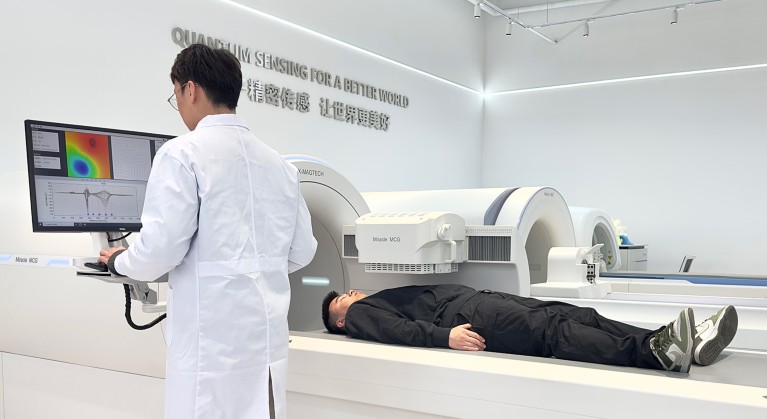
Chinese hospitals are testing magnetocardiography machines using Beijing X-Magtech atomic magnetomoters.
The central mass of a brain tumour is relatively straightforward for surgeons to remove — but identifying the full extent of tissue to safely remove presents a bigger challenge, as it may involve regions controlling speech, movement and other crucial functions.
But new atomic magnetometers developed in China might help by measuring the magnetic signals produced by the brain and therefore locate the key functional regions, indicating whether a surgeon should excise tissue.
Organs such as the brain, and muscles, including the heart, generate electrical signals as they work. Accompanying those electrical signals are tiny magnetic fields that have only recently been tapped for information into how the human body works.
“Our natural magnetic fields offer a different perspective to observe the human body and condition,” says Ming Ding, a metrologist at Beihang University in Beijing, and chief scientist of Beijing X-Magtech Technologies Limited.
Novel tool
The company has developed an ultra-sensitive atomic magnetometer which can detect weak magnetic fields generated by the body, with previously untapped applications for healthcare and biomedical research.
Spin-exchange relaxation free (SERF) atomic magnetometers were first developed by researchers at Princeton University in the United States in 20031. They sense weak magnetic fields via gaseous forms of alkali metals, such as rubidium or caesium.
Within the devices these atoms behave like tiny magnets and are aligned with a beam of laser light, explains Bin Cai, the founder of Beijing X-Magtech. This alignment is very sensitive to tiny changes in external magnetic fields.
Electrical measurements of the brain or heart are already used to tell whether someone is having a seizure or a heart attack. But, unlike an electroencephalogram, which detects spikes in activity in the brain during an epileptic seizure for instance, magnetic field measurements can also pinpoint where the spikes are coming from.
In the heart, magnetic field measurements can complement electrocardiograms (ECGs) by identifying which parts of the muscle might be undergoing blood shortages. Beijing X-Magtech’s researchers hope that the atomic magnetometer might even improve understanding of diseases such as Alzheimer’s.
“By the time you detect structural changes in the brain, not much can be done,” says Ding, who wants to know if the magnetometers might be able to detect these changes at an earlier stage than other means.
Future applications
Atomic magnetometers could also serve as a non-invasive tool to enhance routine check-ups or post-treatment heart health monitoring, says Cai.
To test this, some 20 hospitals in China have now begun installing magnetocardiography devices using atomic magnetometers from Beijing X-Magtech, which have so far been approved for use in China, but not yet elsewhere. Another group has also been testing the use of the device to measure movements of the gastrointestinal tract to assess functional gastrointestinal disorders2.
“In clinical settings, we have a lot of technologies already to detect different diseases, but many of them involve radiation or contrast dyes, or invasive procedures,” says Cai. “Our device offers an alternative solution.”
The Beijing X-Magtech researchers are also working to further miniaturize and simplify their products so patients could one day receive health check-ups in their homes.


